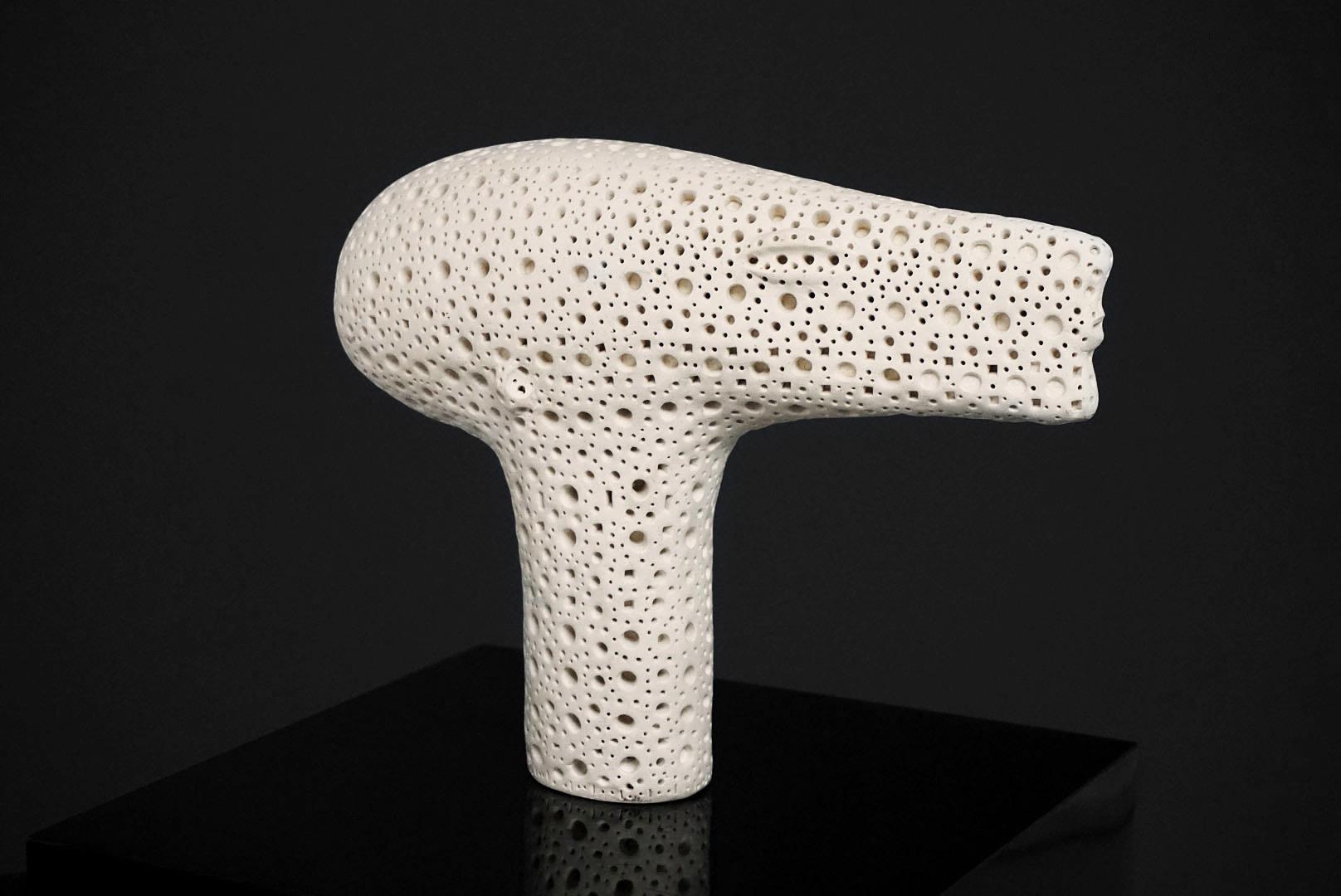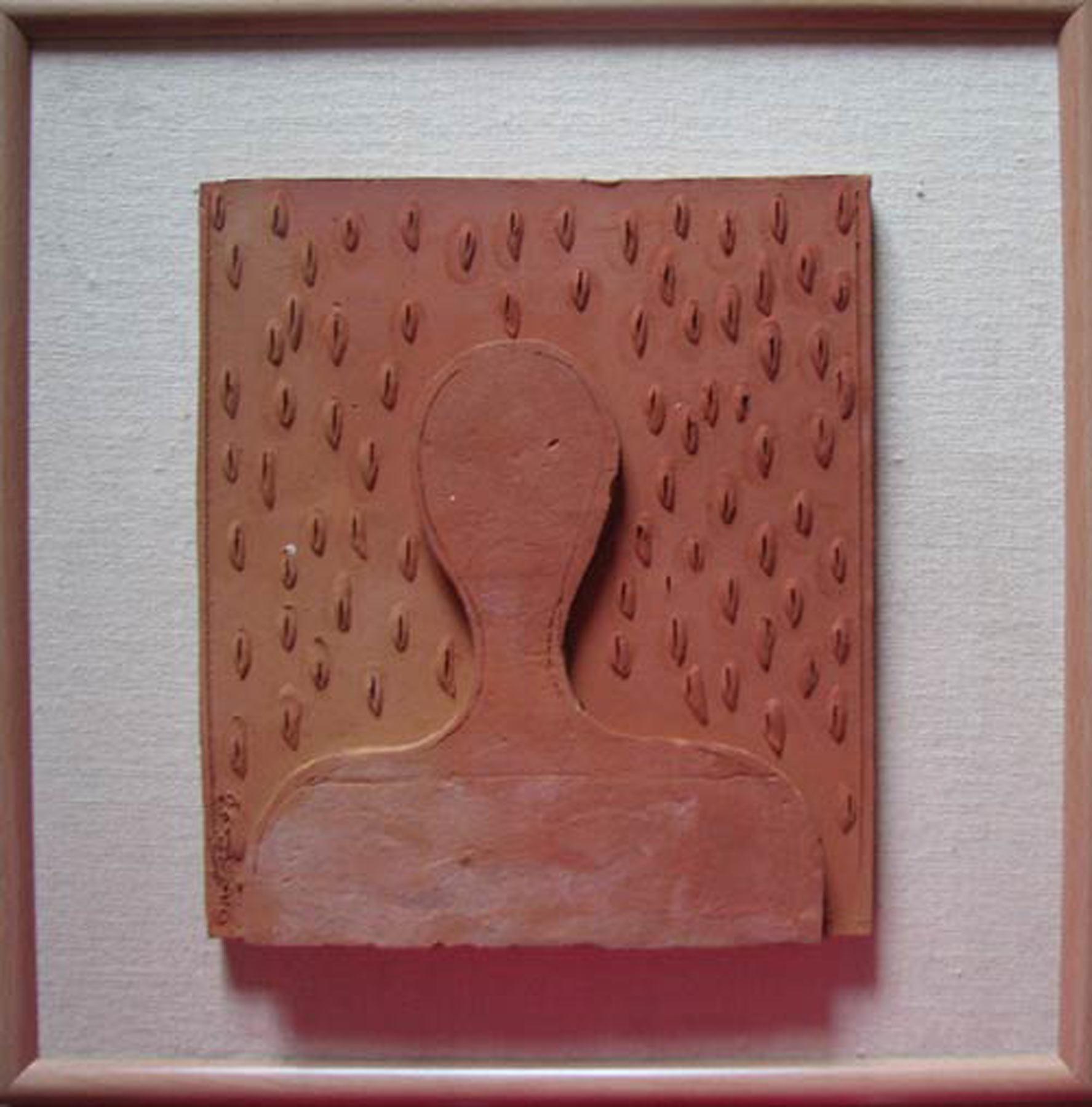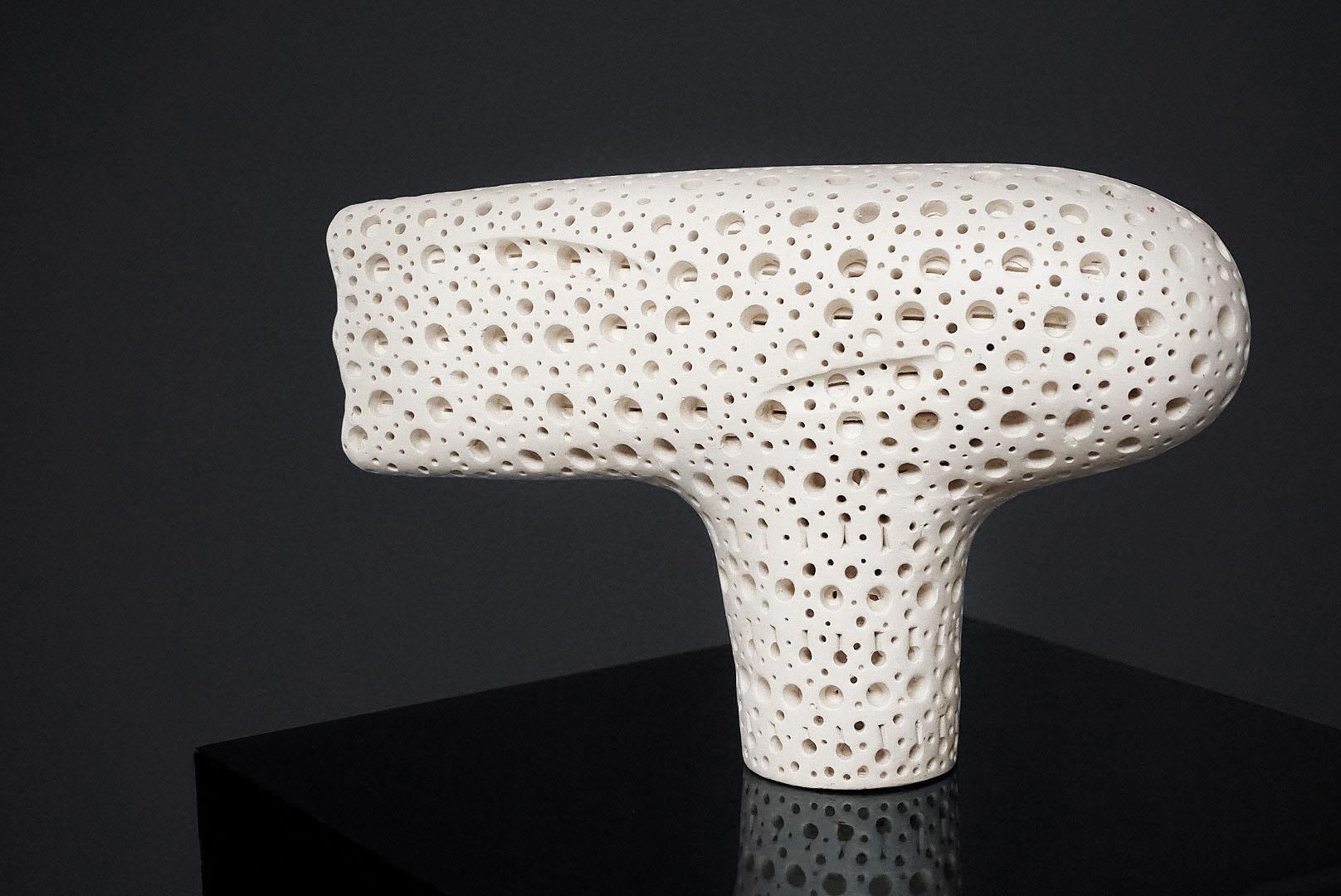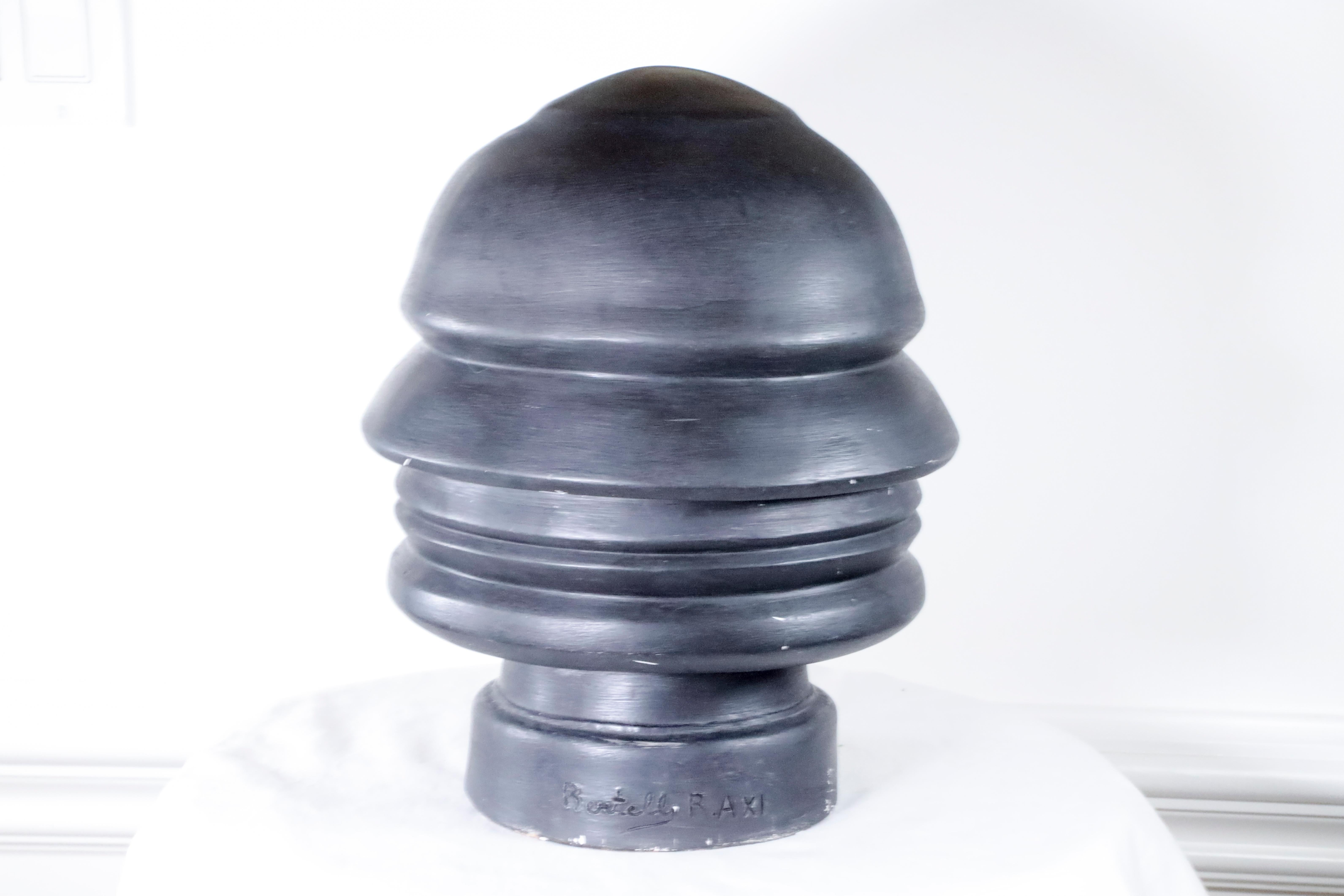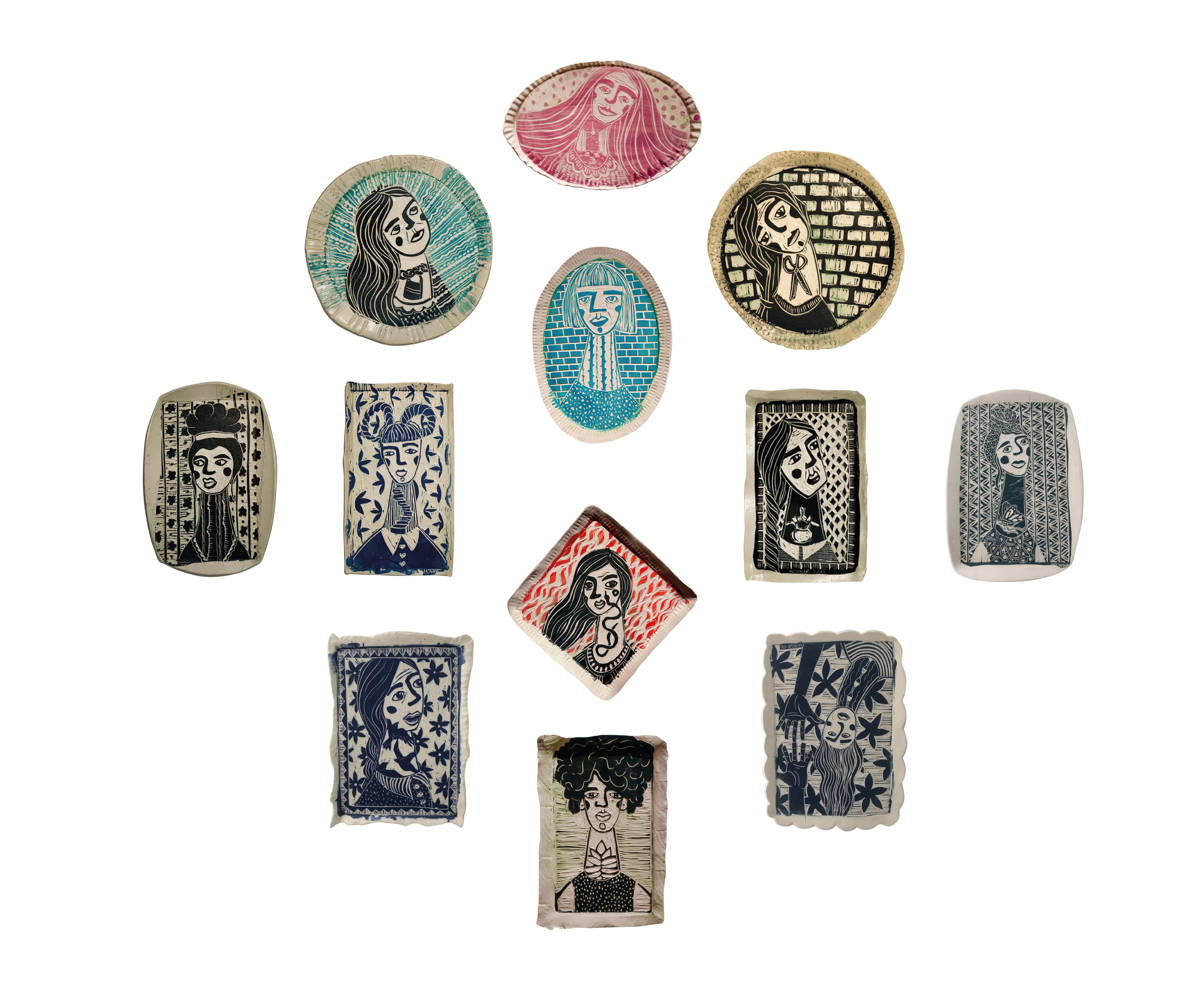Items Similar to Homage à Kahnweiler
Want more images or videos?
Request additional images or videos from the seller
1 of 6
Irmgard BiernathHomage à Kahnweiler1984
1984
About the Item
Irmgard Biernath (1905 Waldheim in Saxony - 1998 Mainz), Hommage à Kahnweiler, 1984. Terracotta relief, burnished red body, 43.5 x 38 cm, mounted on support plate, in wooden frame 57 x 49.5 cm, monogrammed "IB" at lower right.
- Isolated patina losses, but overall good condition, frame slightly bumped.
- The Appearance of Genius-
This homage to Daniel-Henry Kahnweiler shows the gallerist and art theorist as Pablo Picasso portrayed him in his lithographic portrait of 1957.
As an innovative Parisian gallery owner, Kahnweiler had exclusively represented Picasso since 1911, while Picasso had painted his famous portrait of Kahnweiler the previous year as a major work of Cubism. And it is Picasso who appears at the centre of Irmgard Biernath's image. Here, his face echoes the features of the self-portrait he painted in 1907 in the Prague National Gallery.
His eyes are wide open as he gazes into the distance, surrounded by the works of his artistic vision that have already taken shape. On the right is the bronze "Man with Sheep" from 1943, and on the left a flower representing Picasso's painterly work.
Kahnweiler, who was closely associated with Picasso's work, looks at the sculptures on the table in front of him with great attention and admiration. His head joins the sculptures and the flower to form a circle that surrounds Picasso's face like a wreath of honor, so the homage to Kahnweiler is first and foremost a homage to Picasso. As a sculptor inspired by Picasso's work, Irmgard Biernath herself follows in the footsteps of the artistic genius, whose face she makes appear on her relief as on the sweat shroud of Veronica.
About the artist
Irmgard Biernath worked as a teacher in Berlin from 1929. Because of her denunciation in 1941, she voluntarily resigned from teaching. After the Second World War, she followed her true calling as an artist and studied from 1946 at the Berlin-Weißensee School of Art with Bernhard Heiliger and from 1948 at the Nuremberg Academy of Fine Arts, where she was a master student of Hans Wimmer, among others. To earn a living, she taught art at the Anne Frank Realschule in Mainz from 1953 to 1971, for which she created a bust of Anne Frank. From 1958 to 1964 she was also a lecturer at the University Institute for Art and Work Education in Mainz. In addition, she was active at the Volkshochschule (adult education center), where she established the field of art education with her concept "Forming Hands" and left her mark for decades. From the 1960s on, Irmgard Biernath devoted herself more and more to her own work, working exclusively as a freelance artist since 1971.
Irmgard Biernath's artistic estate is housed in the museum of her hometown of Waldheim, where the Irmgard Biernath Foundation is also located.
Irmgard Biernath received numerous awards. Among others, she received the Federal Cross of Merit in 1976, the Rembrandt Medal in 1990, and the Mainz Plate, also in 1990.
Exhibitions
Kennen Sie ...? Biernath! Werke aus dem Nachlass der Bildhauerin Irmgard Biernath, Kulturzentrum Waldheim 2011.
Harmonie und Gleichgewicht im Werk der Irmgard Biernath, Stadt- und Museumshaus Waldheim, 2022.
Selected Bibliography
Irmgard Biernath (Hrsg.): Irmgard Biernath, Mainz 1990.
Marlene Hübel: Irmgard Biernath. Ein Lebenswerk, Mainz 1995.
Saur. Allgemeines Künstlerlexikon, Band 10, München - Leipzig 1995, S. 576-577.
GERMAN VERSION
Irmgard Biernath (1905 Waldheim in Sachsen - 1998 Mainz), Hommage à Kahnweiler, 1984. Terracotta-Relief, brünierter roter Scherben, 43,5 x 38 cm, auf Trägerplatte montiert, im Holzrahmen 57 x 49,5 cm, rechts unten mit „IB“ monogrammiert.
- Sehr vereinzelte Verluste der Patina, insgesamt aber wohlerhalten, Rahmen etwas bestoßen.
- Die Erscheinung des Genius -
Die Hommage an Daniel-Henry Kahnweiler zeigt den Galeristen und Kunsttheoretiker in der Art wie ihn Pablo Picasso in seinem lithographischen Porträt von 1957 dargestellt hat.
Als innovativer Pariser Galerist hatte Kahnweiler Picasso ab 1911 exklusiv vertreten, während Picasso im Jahr zuvor sein berühmtes Porträt Kahnweilers als ein Hauptwerk des Kubismus malte. Und Picasso ist es, der im Zentrum des Bildes von Irmgard Biernath erscheint. Dabei folgt sein Antlitz den Zügen des 1907 geschaffenen Selbstporträts der Prager Nationalgalerie.
Mit weit geöffneten Augen schaut er in die Ferne, während er bereits von den gestaltgewordenen Werken seiner künstlerischen Vision umgeben ist. Rechts neben ihm steht die Bronze „Mann mit Schaf“ aus dem Jahre 1943 und links ist eine Blume zu sehen, die für Picassos malerischen Werk einsteht.
Voller Aufmerksamkeit betrachtet der mit dem Werk Picassos eng verbundenen Kahnweiler die vor ihm auf dem Tisch situierten Skulpturen, zu denen er bewundernd aufblickt. Dabei verbindet sich sein Kopf mit den Skulpturen und der Blume zu einer Picassos Antlitz wie ein Ehrenkranz umgebenden Kreisform, weshalb die Hommage an Kahnweiler vor allem eine Hommage an Picasso ist. Als eine von Picassos Oeuvre inspirierte Bildhauerin tritt Irmgard Biernath selbst in die Fußstapfen des Künstlergenies, dessen Antlitz sie auf ihrem Relief wie auf dem Schweißtuch der Veronika zur Erscheinung bringt.
zur Künstlerin
Irmgard Biernath war ab 1929 Lehrerin in Berlin. Aufgrund ihrer Denunziation 1941 schied sie freiwillig aus dem Schuldienst aus. Nach dem Zweiten Weltkrieg folgte sie ihrer eigentlichen Berufung als Künstlerin und studierte ab 1946 an der Kunsthochschule Berlin-Weißensee bei Bernhard Heiliger und ab 1948 an der Akademie der Bildenden Künste Nürnberg, wo sie unter anderem Meisterschülerin bei Hans Wimmer war. Um den Brotererb zu sichern, war sie von 1953 bis 1971 Kunstlehrerin an der Mainzer Anne Frank Realschule, für die sie eine Büste der Anne Frank schuf. Von 1958 bis 1964 war sie auch Dozentin am Hochschulinstitut für Kunst- und Werkerziehung Mainz. Zudem war sie an der Volkshochschule tätig, wo sie den Bereich Kunsterziehung mit ihrem Konzept der „Formende Hände“ aufbaute und über Jahrzehnte hinweg prägte. Ab den 1960er Jahre widmetet sich Irmgard Biernath zusehend ihrem eigenen Schaffen, um dann ab 1971 ausschließlich als freischaffende Künstlerin tätig zu sein.
Der künstlerische Nachlass befindet sich im Museum ihrer Geburtsstadt Waldheim, wo auch die Irmgard-Biernath-Stiftung ansässig ist.
Irmgard Biernath wurden zahlreiche Ehrungen zuteil. So erhielt sie unter anderem 1976 das Bundesverdienstkreuz, 1990 die Rembrandt-Plakette und ebenfalls 1990 den Mainzer Teller.
Ausstellungen
Kennen Sie ...? Biernath! Werke aus dem Nachlass der Bildhauerin Irmgard Biernath, Kulturzentrum Waldheim 2011.
Harmonie und Gleichgewicht im Werk der Irmgard Biernath, Stadt- und Museumshaus Waldheim, 2022.
Auswahlbibliographie
Irmgard Biernath (Hrsg.): Irmgard Biernath, Mainz 1990.
Marlene Hübel: Irmgard Biernath. Ein Lebenswerk, Mainz 1995.
Saur. Allgemeines Künstlerlexikon, Band 10, München - Leipzig 1995, S. 576-577.
- Creator:Irmgard Biernath (1905 - 1998, German)
- Creation Year:1984
- Dimensions:Height: 17.33 in (44 cm)Width: 14.97 in (38 cm)Depth: 1.97 in (5 cm)
- Medium:
- Movement & Style:
- Period:
- Condition:
- Gallery Location:Berlin, DE
- Reference Number:1stDibs: LU2438213127682

About the Seller
5.0
Vetted Seller
These experienced sellers undergo a comprehensive evaluation by our team of in-house experts.
Established in 2014
1stDibs seller since 2023
7 sales on 1stDibs
Typical response time: 3 hours
- ShippingRetrieving quote...Ships From: Berlin, Germany
- Return PolicyA return for this item may be initiated within 14 days of delivery.
More From This SellerView All
- Madonna del Dito - Heavenly beauty down to the fingertip -Located in Berlin, DEKPM, Madonna del Dito, oval, slightly curved porcelain picture plate by KPM Berlin in fine polychrome onglaze painting, 27 x 22 cm (plate size), 33 x 28.5 cm (frame), unsigned, press...Category
1880s Academic More Art
MaterialsPorcelain, Oil
- Two countrywomen with a donkey - Melancholy in an atmosphere of colour -Located in Berlin, DEPierre Louis De La Rive (1753 Geneva - 1817 Geneva). Two countrywomen with a donkey. Oil on canvas, mounted, 27 x 20 cm (visible size), 37 x 31 (frame), monogrammed "P.R." at lower right. About the artwork De La Rive has taken the typical scenes of Dutch landscape genre paintings...Category
1790s Old Masters Figurative Paintings
MaterialsCanvas, Oil
- Ballerina in the dressing roomLocated in Berlin, DEKarl Stohner (1894 Mannheim - 1957 Paris), Ballerina in the dressing room, 1924. Pastel on painting cardboard, 65 x 45 cm, 77,5 x 59,5 (frame), signed lower left "Stohner" and dated "[19]24". Behind glass in gold stucco frame of the time. - Painting cardboard slightly warped, in the lower area minimally stained, frame with age patina and traces of abrasion. - The Naturalness of Artificiality - We see a ballerina putting on her right ballet shoe while the left one is still lying on the floor in front of her. It is precisely the casualness of the scene that gives it its intimacy: the blonde young woman is completely absorbed in the activity of getting ready for the dance, oblivious to us, while we are positioned right in front of her in the dressing room, inaccessible to the audience, watching her dress. Even though she does not yet perform a dance step, there is a graceful elegance in the action shown that seems quite natural in contrast to the rehearsed art form of dance. The young woman is not presenting herself to an audience in a perfectly formed movement, but is performing an everyday action, unaware that she is being watched. Concentrated, almost devotional, she pulls the ballet slipper over the verses, not noticing that one of the straps of the tutu has slipped off her shoulder, reinforcing the erotic moment of the scene. Inspired by Edgar Degas, Karl Stohner has painted the scene in strong pastel tones. The dominant blues and turquoises give the scene a magical, mysterious quality and, like the pink of the stockings and ballet slippers, are borrowed from Degas's dancers. Degas's colors, however, are cooler tempered, which is particularly evident in the light impasto applied incarnate. This is where the vividness of Auguste Renoir comes into play, making the dancer seem entirely flesh and blood. Karl Stohner, who has studied the pastels of Degas and Renoir intensively, combines the two artists here to create his own pictorial language. He has laid out the background in broad layers of strokes, ranging in color from white to turquoise to dark blue. The result is a dynamic, pattern-like structure that contrasts with the woman's calm, inward-looking posture. The fund anticipates the dynamics of the choreography of the dance for which the ballerina is preparing. At the same time, the broad pastel line in the background is an adequate means of painting to depict the soft, flowing elegance of the dancer. About the artist Against the wishes of his wealthy parents, Karl Stohner decided to become a painter. His talent was discovered by the director of the Mannheim Art Gallery, Fritz Wichert, who supported him from then on, including financing study trips to Paris. There he discovered the art of Degas, Cézanne and Renoir, which inspired his work. GERMAN VERSION Karl Stohner (1894 Mannheim - 1957 Paris), Ballerina im Ankleideraum, 1924. Pastell auf Malkarton, 65 x 45 cm, 77,5 x 59,5 (Rahmen), unten links mit „Stohner“ signiert und auf „[19]24“ datiert. Hinter Glas im Goldstuckrahmen der Zeit. - Malkarton leicht verzogen, im unteren Bereich minimal fleckig, Rahmen mit Alterspatina und Abriebspuren - Die Natürlichkeit der Kunstform - Wir sehen eine Ballerina, die sich den rechten Ballettschuh anzieht, während der linke noch vor ihr auf dem Boden liegt. Gerade aus der Beiläufigkeit der Szenerie speist sich ihre Intimität: Die blonde...Category
1920s Post-Impressionist Figurative Paintings
MaterialsPastel
- Still life with meadow flowers - The beauty of meadow flowers -Located in Berlin, DEJean-Baptiste Robie (1821 Brussels - 1910 ibid.). Still life with meadow flowers. Oil on wood, 24.5 x 18.5 cm (inside measurement), 37 x 31 cm (frame), signed and dated (difficult to...Category
Early 1900s Naturalistic Still-life Paintings
MaterialsCanvas, Oil
- Rudolf v. Rittner as Florian Geyer - Last man standing -By Lovis CorinthLocated in Berlin, DELovis Corinth (1858 Tapiau - 1925 Zandvoort), Rudolf von Rittner as Florian Geyer, 1924 (Müller 854), drypoint signed in pencil. 20.4 × 14.2 (plate size), 37.7 × 30.6 cm (sheet size). Published by Karl Nierendorf, Berlin. Framed in a passepartout. - Strong, precise impression. Frame a little bit rubbed and with two small damages. About the artwork The knight is a leitmotif in Lovis Corinth's work, culminating in his Self-Portrait in Armour of 1914. Of all the paintings on this theme, Corinth most often depicted Florian Geyer. Descended from a Franconian noble family, he fought for the freedom of the peasants during the peasant wars of the Reformation, first diplomatically and then militarily, leading the legendary Schwarzen Haufen (Black Troops). The name derives from the black uniforms with which Geyer dressed the peasants willing to fight. During the Napoleonic occupation, the freedom fighter Florian Geyer was sung about by the Romantics, and the free corps Die Schwarze Schaar, founded in 1813 by Major von Lützow, succeeded the Schwarzer Haufen. It was against this historical background that Gerhard Hauptmann wrote the revolutionary drama Florian Geyer, which premiered at the Deutsches Theater in Berlin in 1896. While the actor Rudolf Rittner, who would later appear in Fritz Lang's films, initially played the role of Schäferhans, he took over the leading role in the new production at Berlin's Lessing Theatre in 1904, again directed by Emil Lessing, which established his fame as an actor. Hauptmann himself praised the acting. He wrote to Hugo von Hofmannsthal: "It went quite well with Florian Geyer. In any case, I had the great pleasure of seeing the play again in an admirable performance". And Lovis Corinth was so taken with Rittner's performance that he painted an oil portrait of him in the role of Florian Geyer in 1906. After two further graphic versions in 1915 and 1920/21, Corinth returned to the painting a year before his death and almost twenty years after the oil painting to create this graphic version in 1924. Even the inscription in the picture was taken over. This proves all the more the importance of the knight and freedom fighter for Corinth's self-image. The oil painting, in particular, proclaims the single-minded determination to fight to the last for the values defended, manifested in the oil painting by the tattered flag held out to the enemy. There is a parallel with Rainer Maria Rilke's 1899 story The Cornet, in which the protagonist goes down with the flag that he first saved at the risk of his life. Consequently, the portrait is also a self-portrait, and the knight's armour is not an academic costume or an ironic refraction, but an expression of Corinth's self-image, which also includes his self-representation as an artist. The Secession poster...Category
1920s Expressionist Figurative Prints
MaterialsEtching
- Evening - The depth of the visible -Located in Berlin, DEMax Clarenbach (1880 Neuss - Cologne 1952), Evening. Etching, 18 x 41 cm (platemark), 33.5 x 57 cm (frame), inscribed "Abend" in pencil at lower left, signed and dated "M. Clarenbach. 28.III.[19]09". Framed and mounted under glass. - Somewhat browned and slightly foxed. About the artwork The horizontally elongated etching depicts the panoramic view of a small town as seen from the other side of the river. There are gabled houses on the left and a mighty church spire on the right. The bourgeois houses and the large religious building indicate the urban character. These buildings are rendered in dark tones to emphasise the lighter row of houses in the centre of the picture, closer to the water. The chiaroscuro contrast creates two parallel planes that open up a space for the imagination of what the city could be. The imagination is stimulated by the almost entirely dark, barely recognisable buildings, while the arm of the river leading into the city further stimulates the imagination. However, as the silhouette of the city as a whole is reflected in the water, the parallel planes are perceived as a band of houses that stretches across the entire horizontality of the etching and seems to continue beyond the borders of the picture. The reflection has almost the same intensity as the houses themselves, so that the band of buildings merges with their reflection to form the dominant formal unit of the picture. Only the parallel horizontal hatching creates the convincing impression of seeing water, demonstrating Max Clarenbach's mastery of the etching needle. The water is completely motionless, the reflection unclouded by the slightest movement of the waves, creating a symmetry within the formal unity of the cityscape and its reflection that goes beyond the motif of a mere cityscape. A pictorial order is established that integrates everything in the picture and has a metaphysical character as a structure of order that transcends the individual things. This pictorial order is not only relevant in the pictorial world, but the picture itself reveals the order of the reality it depicts. Revealing the metaphysical order of reality in the structures of its visibility is what drives Clarenbach as an artist and motivates him to return to the same circle of motifs. The symmetry described is at the same time inherent an asymmetry that is a reflection on art: While the real cityscape is cut off at the top of the picture, two chimneys and above all the church tower are not visible, the reflection illustrates reality in its entirety. The reflection occupies a much larger space in the picture than reality itself. Since antiquity, art has been understood primarily as a reflection of reality, but here Clarenbach makes it clear that art is not a mere appearance, which can at best be a reflection of reality, but that art has the potential to reveal reality itself. The revealed structure of order is by no means purely formalistic; it appears at the same time as the mood of the landscape. The picture is filled with an almost sacred silence. Nothing in the picture evokes a sound, and there is complete stillness. There are no people in Clarenbach's landscape paintings to bring action into the picture. Not even we ourselves are assigned a viewing position in the picture, so that we do not become thematic subjects of action. Clarenbach also refrains from depicting technical achievements. The absence of man and technology creates an atmosphere of timelessness. Even if the specific date proves that Clarenbach is depicting something that happened before his eyes, without the date we would not be able to say which decade, or even which century, we are in. The motionless stillness, then, does not result in time being frozen in the picture, but rather in a timeless eternity that is nevertheless, as the title "Abend" (evening), added by Clarenbach himself, makes clear, a phenomenon of transition. The landscape of the stalls is about to be completely plunged into darkness, the buildings behind it only faintly discernible. The slightly darkened state of the sheet is in keeping with this transitional quality, which also lends the scene a sepia quality that underlines its timelessness. And yet the depiction is tied to a very specific time. Clarenbach dates the picture to the evening of 28 March 1909, which does not refer to the making of the etching, but to the capture of the landscape's essence in the landscape itself. If the real landscape is thus in a state of transition, and therefore something ephemeral, art reveals its true nature in that reality, subject to the flow of phenomena, is transferred to an eternal moment, subject to a supra-temporal structure of order - revealed by art. Despite this supratemporality, the picture also shows the harbingers of night as the coming darkening of the world, which gives the picture a deeply melancholy quality, enhanced by the browning of the leaf. It is the philosophical content and the lyrical-melancholic effect of the graphic that give it its enchanting power. Once we are immersed in the image, it literally takes a jerk to disengage from it. This etching, so characteristic of Max Clarenbach's art, is - not least because of its dimensions - a major work in his graphic oeuvre. About the artist Born into poverty and orphaned at an early age, the artistically gifted young Max Clarenbach was discovered by Andreas Achenbach and admitted to the Düsseldorf Art Academy at the age of 13. "Completely penniless, I worked for an uncle in a cardboard factory in the evenings to pay for my studies.” - Max Clarenbach At the academy he studied under Arthur Kampf, among others, and in 1897 was accepted into Eugen Dücker...Category
Early 1900s Realist Landscape Prints
MaterialsEtching
You May Also Like
- Alexander Ney, 'Teacher' Unique Sculpture, 2008By Alexander NeyLocated in New York, NYThe unique minimalist ‘Teacher’ sculpture by visionary artist Alexander Ney is handcrafted using italian white terra cotta, created in 2008. Ney is a contemporary visual artist, work...Category
Early 2000s Contemporary Figurative Sculptures
MaterialsTerracotta
- Terracotta, Plate , Brick, Brown, Black colors by Indian Artist "In Stock"By Gautam DasLocated in Kolkata, West BengalGautam Das - Untitled - 8.5 x 8.5 inches Gautam Das is a master Terracotta and mural Artist. He studied in the Kala Bhavana and currently presides as th...Category
Early 2000s Contemporary Figurative Sculptures
MaterialsTerracotta
- Alexander Ney, 'Guardian' Unique Sculpture, 2012By Alexander NeyLocated in New York, NYThe ‘Guardian’ by visionary artist Alexander Ney was handcrafted using italian white terra cotta in 2008. Ney began his professional career as a highly productive visual artist, as a...Category
2010s Minimalist Figurative Sculptures
MaterialsTerracotta
- Continuous Profile of Mussolini "Profilo ContinuoLocated in Brookville, NYRenato Giuseppi Bertellis Born in 1900 in Lastra a sign and died in Florence in 1974. The title is sometimes given as Head of Mussolini, but is better known as Head of Mussolini (Continuous Profile), Continuous profile of Mussolini...Category
Mid-20th Century Futurist Figurative Sculptures
MaterialsTerracotta
- Portraits from the In Light of Her, Series. Carved Porcelain Wall Sculpture SetLocated in Miami Beach, FLPortraits from the In Light of Her, Series. Carved Porcelain Wall Sculpture Set Room in a Room, Lock and Key, Chin Up, Protective Linings, Bamboo Backbone Woman, Stairway to Nowhere Girl, Supporting Perspective, Madame Monarch, Flight Risk, Snake Got Your Tongue, Falling Backwards, Earnest Eve. Overall size: 44.5 in. H x 44 in. W One of a kind Each piece can be sold separately Her poetic porcelain plates...Category
2010s Contemporary Figurative Sculptures
MaterialsClay, Porcelain
- Red glossy ceramic popsicleLocated in Tel Aviv, ILGlossy ceramic popsicle sculpture handmade for wall installation. Available at Variant colorful glaze. Harmony and grandeur characterize the work of Reli Smith and Osnat Yaffe Zimme...Category
Early 20th Century Contemporary Figurative Sculptures
MaterialsCeramic, Glaze
Recently Viewed
View AllMore Ways To Browse
Flower Head Sculpture
Terracotta Sheep
Relief Sculpture Face
1960s Wooden Sculpture
Wreath Sculpture
Terracotta Sculpture Face
Sheep Sculptors
Circle Table Sculpture
Sculpture Terracotta Man
Wooden Sheep
Vintage 1929 Hat
Vintage Wo
Picasso Bust
Red Table For Den
Vintage Flower Wreath
Vintage Flowers Wreath
1960s Dior Hat
Bronze Bust German
